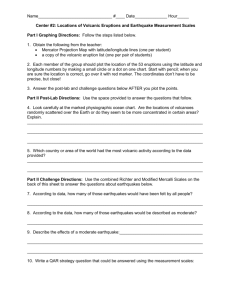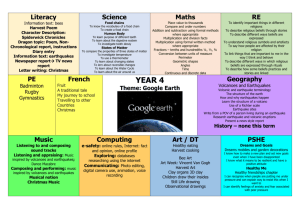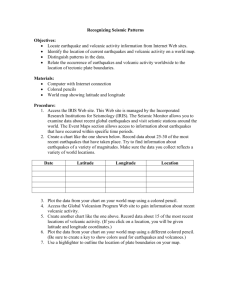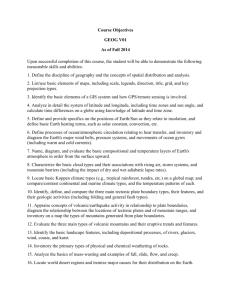Mapping earthquake and volcanic activity
advertisement
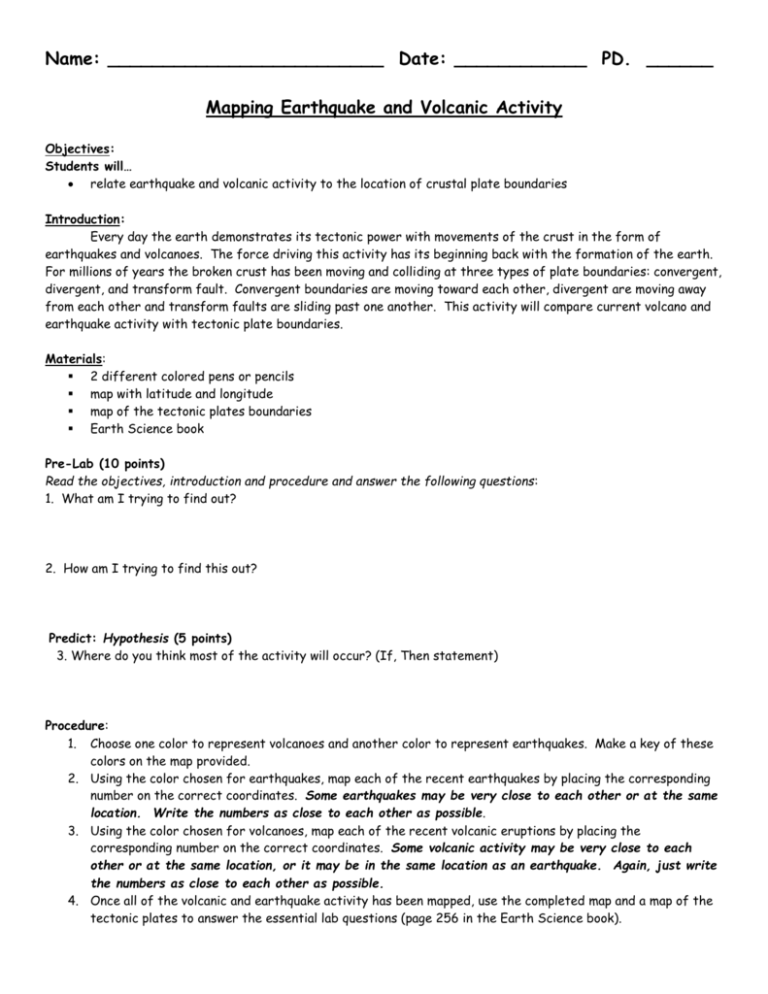
Name: _________________________ Date: ____________ PD. ______ Mapping Earthquake and Volcanic Activity Objectives: Students will… relate earthquake and volcanic activity to the location of crustal plate boundaries Introduction: Every day the earth demonstrates its tectonic power with movements of the crust in the form of earthquakes and volcanoes. The force driving this activity has its beginning back with the formation of the earth. For millions of years the broken crust has been moving and colliding at three types of plate boundaries: convergent, divergent, and transform fault. Convergent boundaries are moving toward each other, divergent are moving away from each other and transform faults are sliding past one another. This activity will compare current volcano and earthquake activity with tectonic plate boundaries. Materials: 2 different colored pens or pencils map with latitude and longitude map of the tectonic plates boundaries Earth Science book Pre-Lab (10 points) Read the objectives, introduction and procedure and answer the following questions: 1. What am I trying to find out? 2. How am I trying to find this out? Predict: Hypothesis (5 points) 3. Where do you think most of the activity will occur? (If, Then statement) Procedure: 1. Choose one color to represent volcanoes and another color to represent earthquakes. Make a key of these colors on the map provided. 2. Using the color chosen for earthquakes, map each of the recent earthquakes by placing the corresponding number on the correct coordinates. Some earthquakes may be very close to each other or at the same location. Write the numbers as close to each other as possible. 3. Using the color chosen for volcanoes, map each of the recent volcanic eruptions by placing the corresponding number on the correct coordinates. Some volcanic activity may be very close to each other or at the same location, or it may be in the same location as an earthquake. Again, just write the numbers as close to each other as possible. 4. Once all of the volcanic and earthquake activity has been mapped, use the completed map and a map of the tectonic plates to answer the essential lab questions (page 256 in the Earth Science book). Coordinates: EARTHQUAKES Longitude Latitude 154 0 E 460 N 126 E 1N 146 E 54 S 144 E 20 N 178 W 29 N 126 E 1S 100 E 0.5 S 100 E 0.5 S 76 W 2N 48 E 33 N 169 E 20 S 136 E 37 N 169 E 20 S 157 E 8S 155 E 7S 136 E 34 N 72 W 45 S 179 W 19 S VOLCANOES Longitude 150 E 55 E 83 W 168 E 123 E 159 E 155 W 160 E 145 E 152 E 78 W 112 E 161 E 62 W 122 W 129 E 78 W 70 W Latitude 370 N 21 S 10 N 16 S 7S 54 N 19 N 56 N 4S 4S 2S 8S 56 N 16 N 46 N 29 N 1S 16 S Essential Lab Questions; 1. Overall, what did you find out about this lab? ________________________________________________________________________________ ________________________________________________________________________________ 2. What does this mean to you, how will it affect you in real life? ________________________________________________________________________________ ________________________________________________________________________________ 3. Why should you care (don’t tell me you don’t)? ________________________________________________________________________________ ________________________________________________________________________________ 4. Which directional areas on the map showed the most earthquake activity? ________________________________________________________________________________ 5. Which directional areas on the map showed the most volcanic activity? ________________________________________________________________________________ 6. Did any directional map location experience both volcanic and earthquake activity? If so, where? ________________________________________________________________________________ ________________________________________________________________________________ 7. Are these areas located at tectonic plate boundaries? If so, which ones? ________________________________________________________________________________ ________________________________________________________________________________ 8. Which type of boundary seems associated with the most earthquakes (3 to choose from)? ________________________________________________________________________________ 9. Which type of boundary seems associated with the most volcanoes (3 to choose from)? ________________________________________________________________________________ 10. The area around the Pacific Plate is often referred to as the Pacific Ring of Fire. Look at the map and the text, if necessary, and explain why it has this name. ________________________________________________________________________________ ________________________________________________________________________________ WEST EAST NORTH SOUTH KEY
